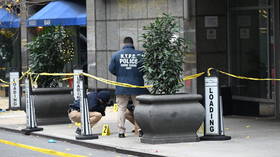A second lockdown for Britain? The evidence simply doesn’t justify it
With few people dying, or even being hospitalised, from Covid-19, why are the UK’s governments seemingly so desperate to slap ever more restrictions on our most basic liberties?
On Monday, the ‘rule of six’ came into effect in the UK. With slight variations across the four nations, it meant that no more than six people can now meet socially, indoors or outdoors. Ministers are deadly serious about it, too, suggesting we snitch on our neighbours if they break the rules.
Worse was to come, however, with more local lockdowns. From Friday, in areas of the northeast of England covering nearly two million people, it will be illegal to meet anyone outside your own household or ‘support bubble’, with exceptions including work and education. It will be possible to meet others at a pub or restaurant, but this is being strongly discouraged.
Other parts of the UK are already under similar measures, including Birmingham and Bolton, with around 11 million people facing lockdown measures currently or very soon.
This is all a serious infringement upon our personal freedoms. We're not yet at the level of the national lockdown that began in March nor even the widespread closure of businesses in Leicester in June. But if some influential people have their way, that might be coming.
There are now reports that experts on the government’s Scientific Advisory Group for Emergencies (SAGE) and the Scientific Pandemic Influenza Group on Modelling (SPI-M) have proposed a two-week lockdown to coincide with the half-term holiday in schools at the end of October. Hospitals are already being told to plan on the basis of clearing beds for coronavirus patients within two weeks. We have plenty of evidence to illustrate the dangers of those patients ending up in care homes when hospitals were cleared out last time.
Yet the situation is very different to the one back in March. Lockdown was implemented on March 23 and figures for the week ending March 27 showed there were 1,568 Covid-19 deaths registered in England. Two weeks later, this had shot up to 6,213 deaths – a third of all deaths in England.
So how are things looking now? The latest ONS figures, for the week ending September 4, state that 78 death certificates mentioned Covid-19, “the lowest number of deaths involving Covid-19 in the last 25 weeks and a 22.8% decrease compared with Week 35 (a difference of 23 deaths), accounting for 1.0% of all deaths in England and Wales.” The August Bank Holiday may have delayed a few registrations, but the current death toll from Covid-19 is clearly very low when compared both to earlier in the year and with the normal level of mortality for the time of year.
What about hospital admissions? They are starting to rise again, which is not surprising for a seasonal illness with summer at an end. Admissions have risen quite sharply. The Covid-19 Actuaries Response Group notes in its latest bulletin, based on official statistics for England: “On 26 August, the seven-day moving average reached a low point of 45 admissions per day. Since then it has almost tripled, reaching 128 on 13 September. It is very clear that admissions are rising, and not just reported cases.”
Also on rt.com Cure worse than the disease? 30 MILLION face starvation as Covid-19 economic shutdown hurts most vulnerable, UN food chief warnsBritish ministers may also be looking with some trepidation across the Channel to France, where hospitalisations have been increasing for longer. The latest Covid-19 figures for French hospitals show 3,223 new hospitalisations in the past week (up 46 percent week-on-week), 535 new ICU admissions (up 44 percent) and 230 new deaths (up 56 percent). These numbers are still well below the figures from March and April, and are growing from a low base, but they are undoubtedly cause for concern.
But it is still the case that most positive tests are among younger people: “In recent weeks, there has been clear evidence of an increase in the number of people testing positive for Covid-19 aged 2 to 11 years, 17 to 24 years and 25 to 34 years.” While nobody would want to be infected with this disease, if growing numbers of younger people, who rarely suffer serious illness, are getting it, it makes it more difficult for the virus to spread easily. In the 17-24 age group, around one percent of those tested were positive. For those over 70, the positive test rate was perhaps one tenth of that.
So why are ministers being so alarmist? Infection rates are rising, and this seems to be showing up now in hospital admissions and mortalities. But the rate of rise is considerably slower than in March. Those worrying French figures are doubling every two weeks, roughly, rather than in just three or four days as was the case earlier in the year. All-cause mortality in England and Wales is, once more, below average for the time of year.
The real problem is the swift turn towards authoritarian measures. Rather than providing information and allowing people to make their own decisions about how much risk to bear – for example, working from home rather than in the office or avoiding pubs – the instinct of the UK’s four governments constantly turns towards legally enforced restrictions.
Nor is it clear what the government is even attempting to do. Back in March, the aim of lockdown was to ‘flatten the curve’ so health services could create greater capacity to treat people. But now? Ministers don’t seem to know whether they are aiming for complete suppression of the virus or a controlled spread that mainly affects the young, while protecting older people. Whatever happens, this virus only goes away when enough people have been infected or if they are vaccinated – and a vaccine probably won’t be available until after the next winter season at the earliest.
The result is one knee-jerk reaction after another with scientific advisers playing a defining role. There seems to be little urgency about dealing with the other accumulated health problems, the profound effect of new restrictions on mental illness and the damage done to the economy by such stop-start-stop policies.
The whole crisis has revealed the limits of public health advice, the underlying inclination to authoritarianism and the weak state of democracy, where new rules can be published literally minutes before they come into force. (The legislation introducing the ‘rule of six’ landed about 20 minutes before it came into force on Monday.) Parliament, having handed over emergency powers earlier in the year, is in no position to scrutinise the government.
While there is no room for complacency with Covid-19, which is clearly a very nasty disease, we should push back against this relentless encroachment on our freedom.
The statements, views and opinions expressed in this column are solely those of the author and do not necessarily represent those of RT.















